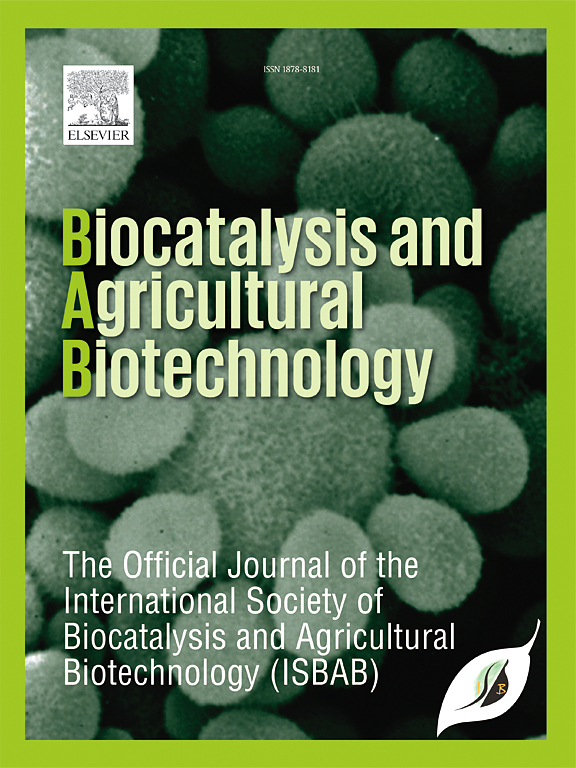Burkholderia sp. EIKU24-derived selenium nanoparticles: Characterization, multifunctional bioactivities and their role in sustainable rice cultivation against arsenic stress
IF 3.4
Q2 BIOTECHNOLOGY & APPLIED MICROBIOLOGY
引用次数: 0
Abstract
The current study employed a rice root plaque-associated bacterium, Burkholderia sp. EIKU24, with the competency to synthesize spherical and crystalline biogenic selenium nanoparticles (BioSeNPs) that have size variability between 230 and 330 nm, as confirmed by SEM and TEM analysis. FT-IR and electron microscopy further revealed a biomolecular coating around the NPs that might have contributed significantly to their antibacterial activity against potential pathogenic Gram-positive and Gram-negative bacteria. The BioSeNPs suspension (10 mg mL−1) inhibited 78 % and 67 % of Staphylococcus aureus and Pseudomonas aeruginosa biofilms, respectively. Furthermore, BioSeNPs showed very high antioxidant capability, reflected by 90 % relative DPPH scavenging activity and photocatalytic capability by the degradation of 86 % methylene blue (10 mg L−1) solution within a contact time of 30 min. Compared to hydro or Na2SeO3 priming, rice seeds from BioSeNPs-priming outperformed in all tested seed germination parameters. Hydroponic cultivation showed better health and growth of the rice plants by an increase in root and shoot lengths, wet and dry biomass, and chlorophyll content, both in arsenic (As)-exposed and unexposed seedlings emerging from BioSeNPs-primed seeds. Notably, in such seedlings, exposure to As did not alter the growth much, indicating increased resilience to As through BioSeNPs priming. Besides, the priming of BioSeNPs decreased the translocation of As to shoot and root by about 50 % compared with hydro priming. The bioactivities, dye degradation, and growth promotion coupled with As resilience in rice seedlings consolidate the sustainable agricultural potential of BioSeNPs. However, their impact on soil ecology and interaction with other contaminants requires further study.

伯克霍尔德氏菌eiku24衍生的硒纳米颗粒:表征、多功能生物活性及其在水稻抗砷胁迫可持续栽培中的作用
目前的研究使用了一种与水稻根菌斑相关的细菌,伯克霍尔德氏菌sp. EIKU24,该细菌具有合成球形和结晶型生物源硒纳米粒子(BioSeNPs)的能力,其大小变化在230到330 nm之间,这一点经扫描电镜和透射电镜分析证实。FT-IR和电子显微镜进一步揭示了NPs周围的生物分子涂层,这可能对其对潜在致病性革兰氏阳性和革兰氏阴性细菌的抗菌活性有重要贡献。BioSeNPs悬浮液(10 mg mL−1)对金黄色葡萄球菌和铜绿假单胞菌生物膜的抑制率分别为78%和67%。此外,BioSeNPs表现出非常高的抗氧化能力,反映在90%的相对DPPH清除活性和在30分钟接触时间内降解86%亚甲基蓝(10 mg L−1)溶液的光催化能力。与水或Na2SeO3引发相比,BioSeNPs引发的水稻种子在所有测试的种子萌发参数中都表现出色。在水培条件下,砷(As)暴露和未暴露的水稻幼苗的根和茎长、干、湿生物量和叶绿素含量均有所增加,显示出更好的健康和生长状况。值得注意的是,在这些幼苗中,暴露于砷并没有对生长产生太大的影响,这表明通过BioSeNPs引发提高了对砷的抵御能力。此外,与水处理相比,BioSeNPs处理能减少茎部和根系中砷的转运约50%。生物活性、染料降解、生长促进以及水稻幼苗抗砷能力巩固了生物senps的可持续农业潜力。然而,它们对土壤生态的影响以及与其他污染物的相互作用有待进一步研究。
本文章由计算机程序翻译,如有差异,请以英文原文为准。
求助全文
约1分钟内获得全文
求助全文
来源期刊

Biocatalysis and agricultural biotechnology
Agricultural and Biological Sciences-Agronomy and Crop Science
CiteScore
7.70
自引率
2.50%
发文量
308
审稿时长
48 days
期刊介绍:
Biocatalysis and Agricultural Biotechnology is the official journal of the International Society of Biocatalysis and Agricultural Biotechnology (ISBAB). The journal publishes high quality articles especially in the science and technology of biocatalysis, bioprocesses, agricultural biotechnology, biomedical biotechnology, and, if appropriate, from other related areas of biotechnology. The journal will publish peer-reviewed basic and applied research papers, authoritative reviews, and feature articles. The scope of the journal encompasses the research, industrial, and commercial aspects of biotechnology, including the areas of: biocatalysis; bioprocesses; food and agriculture; genetic engineering; molecular biology; healthcare and pharmaceuticals; biofuels; genomics; nanotechnology; environment and biodiversity; and bioremediation.
 求助内容:
求助内容: 应助结果提醒方式:
应助结果提醒方式:


